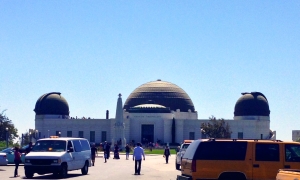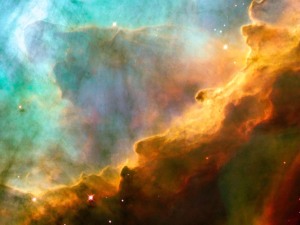Texts: Proverbs 8:22-31 + Psalm 148 + Colossians 1:15-20 + John 6:41-51
We are all stardust. This is most certainly true.
Writing for the famous PBS science series, Nova, Peter Tyson explains,
Every single atom in your body — the calcium in your bones, the carbon in your genes, the iron in your blood, the gold in your filling — was created in a star billions of years ago … You and everything around you, every single natural and man-made thing you can see, every rock, tree, butterfly, and building, comprises atoms that originally arose during the Big Bang or, for all but the lightest two or three elements, from millions of burning and exploding stars far back in the history of the universe. You live because stars died; it’s that simple.
Every atom of my body has traveled the stars, exploding with limitless potential energy in the first nano-seconds of creation.
I wasn’t sure, initially, how to preach on a theme as large as the cosmos. The gift of this task has been to discover in my research how interconnected all of creation is. Not just us and the oceans, or us and the animals, or us and the climate; but us and the stars in the sky, where God forged the atoms from which we are built.
I was given a timely and unexpected opportunity to think about this a week ago today when Kerry and I were in Los Angeles celebrating the installation of Bishop Guy Erwin in the Southwest California Synod. On the advice of friends, we drove up into the hills to Griffith Observatory, best known as the setting for famous scenes from such movies as Rebel Without a Cause and Charlie’s Angels: Full Throttle, but also a very fine planetarium in its own right.

Inside the observatory Kerry and I browsed exhibits on the rotation of the earth, the role of astronomy in the evolution of human society, and the science of photographing the universe. As we wandered through the observatory, one display really caught my attention. It was a series of short films explaining the life cycle of the sun and its relationship to the rest of the galaxy.
Accompanied by scenes of our solar system set against the larger galaxy, the film explains that
Long ago, the sun was smaller and cooler. In the future, it will be very different from today. More than 4 billion years ago, the sun formed from a collapsing cloud of gas and dust. The cloud’s center grew very dense and hot. Gravity pulled the cloud into a spinning disk, where planets formed. As the sun grew more massive, pressure triggered nuclear reactions. The increased energy drove away the remaining dust and gas.
Then the scene shifted from a view of our solar system among the stars to one of our star, the sun, seen from the vantage point of the earth. The film continued, “today then sun is a stable, middle-aged star.”
That’s what caught my attention. I was startled to realize that we have that in common, me and the sun, that we are middle-aged. Granted, the sun has figured out how to be both middle-aged and stable, but it’s had 5 billion years to work on that. I’ve had only forty, so I feel entitled to a little slack in that department.
The film continued,
In a few billion years, it will run out of fuel. It will become a “red giant” star. Its heat will melt the Earth’s surface. After a few million years, the sun’s outer layers will escape to space. When the Sun’s nuclear reactions end, it will collapse to become a “white dwarf” star. It will provide little light or heat to any remaining planets. The sun we know is just one chapter in the long story of our star’s life.

It’s not just that we are like the stars, but that they are like us as well. They are born in stellar nurseries at the center of the galaxy; they burn brightly, but eventually they die as well, their elements returning to the rich, dark sea of interstellar space.
Even then, nothing is wasted. You’ve probably already learned at some point along the way that the light we see when we look up into the night sky has actually been traveling for millions of years before it ever reaches our eye.
So, the light and heat released during those final epochs of our own sun’s life will race through the ever-expanding universe traveling, perhaps, to some unimagined future eye which will behold it.
Our own lives are like the stars. The light and heat of our witness travels forward in time long after we are dead. This morning we catch a glimpse of the light cast by the ancient Israelites who imagined the wisdom of God as if it were God’s only begotten daughter; the first of God’s many creations; the order that organizes the structure of creation to make life possible; God’s great delight, assisting God in bringing the rest of creation into being.
Other points of light in this constellation of scriptures saw the story of Jesus reflected in the image of Lady Wisdom, echoing the story of creation with a new story of re-creation and reconciliation achieved on a cross, at a tree cut down but restored to life.
Jesus, the image of the invisible God, shines brightest of all, the light of his life blazing so brightly it pierces the vast darkness of the heavens above and sheds new light on all of creation. And just as nothing is wasted in the death of a star, so nothing of what Jesus experienced in his sojourn through creation was wasted as well. Even the scorching heat of the crucifixion that desiccated his body proved, in time, to be the super nova that propelled his life-giving presence throughout the known world, transgressing borders and crossing seas.
You live because stars died; it’s that simple.
Jesus tells his followers that he is the bread that came down from heaven, mixing metaphors, playing with our expectations just as wisdom rejoiced in the inhabited world and delighted in the human race.
Jesus, the image of the invisible God, show us who God is and how God wants to be with us. Jesus, naming himself the bread of life, invites us to consume this bit of cosmos wrapped up in flesh. To wrap our own flesh around his light and to be transformed, lifted up and brought to life.
Considering the miracle of life among the vastness of the cosmos, Vicky Balabanksi and Shirley Joh Wurst, two Australian theologians, write,
The cosmos as we know it, both through revelation and through science, is characterized by an impulse to life. One of the great scientific puzzles of our time is the way in which the very nature of the cosmos seems to be intrinsically shaped — even fine-tuned — by the fundamental forces through which the particles of matter interact to make the emergence of life possible. For example, if the weak nuclear force that controls disintegration processes in atomic nuclei were only very slightly weaker or stronger, then supernova explosions would not occur and the stardust of heavy elements essential to life would not have been available to form Earthlike planets. Or, if the strong nuclear force between the proton and neutron were only slightly weaker or stronger, the sun’s processes would have been different from what they are, such that life on Earth could not have developed…
The order of the cosmos reveals an impulse to life. We might use another term for this reality, namely, “grace.” We most frequently think of grace in relation to God’s acts of salvation and redemption, but the fact that we exist at all, in a cosmos imbued with life, is itself a demonstration of grace. God’s grace is the reason there is a world instead of nothing at all or only a swirl of random matter.
So much of the season of creation has been focused on the deep peril now faced by our planet. We’ve studied the oceans, the animals and the storms — each time being brought face to face with the damage we have done and the need to repent, to reverse course, to act.
But we end this season of creation with a celebration of the cosmos, a name for creation so vast that the ancient Israelites and early Christians could barely imagine the multiverse it suggests. Even we, with our satellite telescopes that can paint the mysteries at the center of the galaxy, where stellar nurseries give birth to new stars, have only begun to grasp the vastness of creation.
The cosmos cannot be broken. In its infinitely expanding, accelerating propulsion it precedes our great commission, sending itself ahead of us, testing our ability to dream even a fraction of its reality. The cosmos dwarfs our weapons of mass destruction with infinite creation.
Before it we can only wonder.
In the explanation to the first article of the apostles’ creed, “I believe in God the Father Almighty, Maker of heaven and earth,” Martin Luther writes,
What does this mean? I believe that God has made me and all creatures; that He has given me my body and soul, eyes, ears, and all my limbs, my reason, and all my senses, and still preserves them; in addition thereto, clothing and shoes, meat and drink, house and homestead, wife and children, field, cattle, and all my goods; that He provides me richly and daily with all that I need to support this body and life, protects me from all danger, and guards me and preserves me from all evil; and all this out of pure, fatherly, divine goodness and mercy, without any merit or worthiness in me; for all which I owe it to Him to thank, praise, serve and obey Him. This is most certainly true.
Surrounded, gifted, by the beauty and goodness of God’s creation — all of it born among the stars — what else can we do but thank and praise, serve and obey God by whose grace we and all the cosmos exist, by whose wisdom life emerges from the forces that bind atoms together, by whose love the world is given to us and we are given to the world — all of it a single, vast, interconnected, whole.
We are all stardust. This is most certainly true.
Amen.